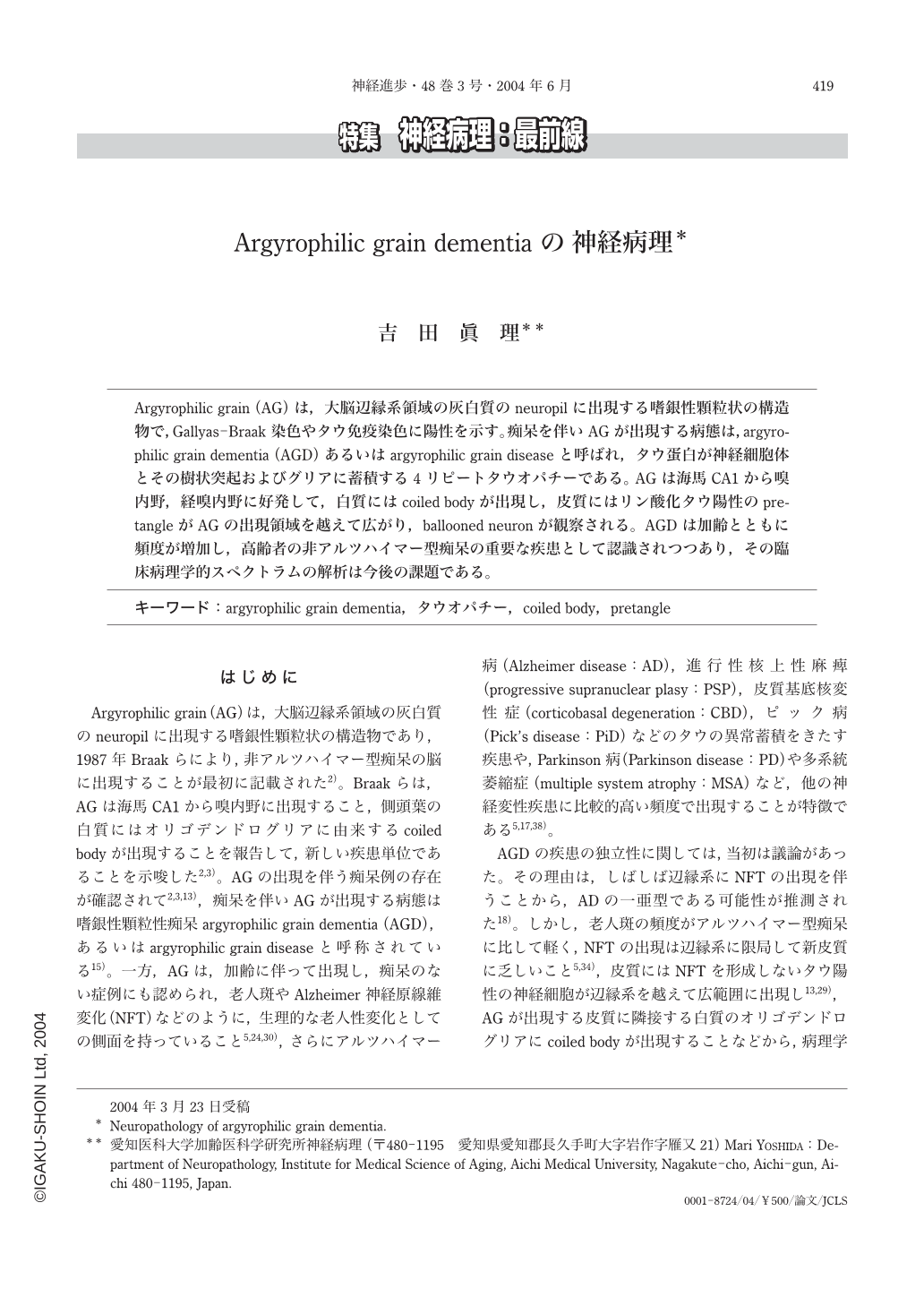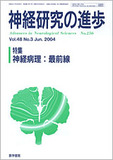Japanese
English
- 有料閲覧
- Abstract 文献概要
- 1ページ目 Look Inside
Argyrophilic grain(AG)は,大脳辺縁系領域の灰白質のneuropilに出現する嗜銀性顆粒状の構造物で,Gallyas-Braak染色やタウ免疫染色に陽性を示す。痴呆を伴いAGが出現する病態は,argyrophilic grain dementia(AGD)あるいはargyrophilic grain diseaseと呼ばれ,タウ蛋白が神経細胞体とその樹状突起およびグリアに蓄積する4リピートタウオパチーである。AGは海馬CA1から嗅内野,経嗅内野に好発して,白質にはcoiled bodyが出現し,皮質にはリン酸化タウ陽性のpretangleがAGの出現領域を越えて広がり,ballooned neuronが観察される。AGDは加齢とともに頻度が増加し,高齢者の非アルツハイマー型痴呆の重要な疾患として認識されつつあり,その臨床病理学的スペクトラムの解析は今後の課題である。
Argyrophilic grain dementia(AGD)is a late onset neurodegenerative disorder characterized by the occurrence of argyrophilic and tau-immunoreactive grains(AG)most abundant in the limbic system, especially in the CA1 region of the hippocampus, the entorhinal and transentorhinal cortex, the adjacent temporal isocortex, the amygdala, the hypothalamic lateral tuberal nuclei, the rectus gyrus, and the septal nuclei. These oval, spindle-shaped or comma-like grains can be best detected by the Gallyas-Braak silver technique. Many tau-immunoreactive pretangles with poor neurofibrillary tangles(NFT)-formation are distributed in the limbic system. Tau-immunoreactive glial changes seen in oligodendroglial coiled bodies and astrocytes represent a consistent finding. Coiled bodies are found in the white matter close to cortical lesions and deep layers of affected cortical areas. Ballooned neurons expressingαB-crystallin are constant features in the amygdala of AGD brains. NFT found in AGD patients generally correspond to early(transitional and limbic)Braak stages.
Macroscopically AGD brains show atrophy of the anterior medial temporal lobe and the posterior hippocampus and entorhinal cortex are relatively preserved. Microscopically neuronal loss and gliosis with spongiosis are found in the superficial layers of anterior medial temporal lobe in additions to tau-immunoreactive AG and the related changes. Selective severe involvement of the ambient gyrus is suggested to be responsible for the clinical manifestation of a limbic-type dementia in AGD. Recently AGD brains with diffuse tau pathology are reported, involving not only temporal lobes but also all cortical, subcortical and brain stem areas. Clinicopathological spectrum of AGD remains to be unclear.
Although the prevalence of AGD cases clearly increases with advancing age, AG are also reported in cognitively normal elderly subjects and in a large variety of neurodegenerative disorders, including progressive supranuclear palsy, corticobasal degeneration, Pick's disease, Parkinson disease, tangle predominant form of senile dementia, Creutzfeldt-Jakob disease, multiple system atrophy and amyotrophic lateral sclerosis.―Its nosological status has been questioned because AGD also exhibits morphological features of Alzheimer's disease, e.g. NFTs and senile plaques. However, many studies have found notable divergent features between AGD and AD.
Recent studies revealed that the pathological tau profile in AGD is characterized by a major tau doublet(64 and 69 kDa)that is distinct from the tau triplet in AD(60, 64 and 69 kDa)and the tau doublet in Pick's disease(PiD). These data support that AGD is a distinct clinicopathological entity within the heterogeneous group of tauopathies.

Copyright © 2004, Igaku-Shoin Ltd. All rights reserved.


